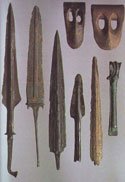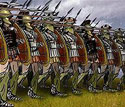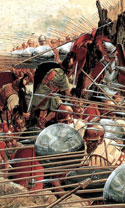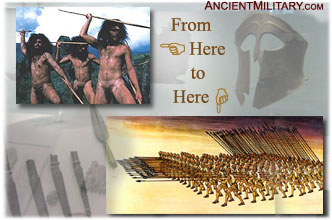|
Ancient Weapons: The Game
Changers
To discuss the entire arsenal of ancient weapons could, and has,
filled volumes of books. For the scope of this series, we will discuss
the general categories, game changers and those that are interesting
and odd. While these weapons are in reality horrific and have caused
untold suffering to humanity, they are still worth our attention.
Advancements in ancient weapons could be the nuclear weapon of the
ancient world, giving on society the edge and dictating the course
of history.
Spears - Primative Weapon of Choice
Spears are one of humankind’s earliest weapons and they reigned
supreme for a hundred thousand years. The material culture of our
Paleolithic (500,000 BC – 8,000 BC) ancestors covers 99% of
the total time that man has been making tools and weapons. This
undoubtedly makes the spear mans most produced weapon. The spear
has been credited with creating 450,000 years of peace on earth,
as even an outnumbered man holding a spear would be deadly to attack
without ranged weapons.
The spear offers its user a level
of protection due to its long reach and found a place in many ancient
armies. The simple spear is a cheap and effective, ancient armies
often combined it with a shield when equipping the ranks of their
heavy infantry units. Spears units were found in many, many ancient
armies from the ancient Sumerians and Egyptian weapons, to the military of ancient India and Japan, and indeed
around the world.
Spear warfare hit its pinnacle of
perfection when used by the Greeks and Macedonians. Spear armed
Greek warriors, called Hoplites, mastered this style of warfare
as their city states battled each other over hundreds of years.
The terrain of Greece is broken up by rough terrain so Greece never
developed the Chariot or Cavalry warfare, but instead focused on
the use of infantry. During the Bronze Age Greek warriors battled in
the heroic style, each man fighting for his own glory independently.
They considered the use of range weapons to be cowardly so their
focus was primarily on heavy infantry. By the classical age of Greek
civilization they had developed formation tactics. The Phalanx was
developed, were rows of hoplites formed a shield wall, the left
side of one hoplites shield protecting the man on his right. Heavily
armored, spear wielding armies would form up and fight set piece
battles. Casualties were generally light until one force’s
formation was broken, then slaughter ensued as they fled. (See Spartan Weapons for mor detials)
The next strategic development took
advantage of this when an astute Theban general, Epaminondas (ca.
410 BC – 362 BC), realized that battles between phalanxes
were essentially giant shoving matches. Whichever phalanx had the
strength to put enough pressure on their opponent caused them to
break formation, route and loose the battle. It was correctly reasoned
that if he loaded up one side of his line and had his weaker side
trailing behind them in an echelon formation that by the time the
week side engaged the enemy the strong side would have already broke
their formation, winning the battle.
Greek hoplite tactics dominated the battlefield of their time; two
massive Persian invasions, the super power of their day, were defeated
by the numerically inferior Greeks. However, the next major development
would be made by their neighbors to the North. Phillip of Macedonia,
who paid attention to Epaminondas' innovations, doubled the length
the spears of his army (to over 18 feet!) and reduced the size of
their shields so his soldiers could hold the long spears with both
hands. This allowed the spears of the first five ranks to protrude
from the formation instead of just the couple ranks like in a Greek
phalanx. Enemies faced an impregnable wall of spear tips. Phillips
son, Alexander the Great, then used this formation to conquer the
known world (335 BC – 326 BC).
After reaching its zenith in the conquests of Alexander the Great
, the phalanx began a slow decline. Phillip and Alexander understood
that a phalanx was could easily be destroyed if not supported; Soldiers
could not defend themselves from attacks from the flanks, the ponderous
phalanx lacked maneuverability and had difficulty holding formations
on rough ground. Calvary, light infantry and skirmishers were deployed
in combination with the phalanx. The tactics of Alexander and his
father were gradually replaced by a return to the simpler assault
tactics of the hoplite phalanx after his death.
The Roman military dropped the inflexible phalanx during the early Roman Republic in favor
of a more flexible system after suffering major setbacks in their
decade’s long war against the Samnite hill tribes. Around
the year 315 BC adopted the system of the Samnites, called the maniple
system, that allowed for more flexibility in the rugged hills of
Samnium where the Romans were forced to fight. The maniple system
has been called a phalanx with joints, each square maniple, about
120 men, could function as an independent unit. The maniples were
arrayed in a checker board pattern; this allowed space for skirmishers
to retreat through the gaps when the heavy infantry closed on their
enemies. The front two rows of maniples would then form a single
line and battle the enemies. When this line tired it could then
retreat through the spaces of the maniples behind it without disrupting
their formations, and a fresh line of soldiers would take up the
fight. Maniples could also be detached to protect flanks or any
other task. The Roman heavy infantry was organized into three lines,
the first two lines used short, double edged stabbing swords and
the last armed with spears. The youngest men formed the first line,
the hastati , after they tired they would fall back through gaps
in the next line, the principes. The more experienced principes
would then continue the fight, if they were having trouble they
could then retreat behind the Triarii. The triarii were the final
line and most experienced soldiers.
In the Pyrrhic War (280–275 BC) Rome proved that they were
capable of competing with the armies of the Hellenistic kingdoms
— the successor kingdoms of Alexander and the dominant Mediterranean
powers of the time. The legions fought the Hellenistic, Macedonian
style phalanxes to a bloody draw, forcing Pyrrhus of Epirus to leave
Italy. Seventy five years later the Romans fought the Macedonians
and their phalanx in the Second Macedonian War (200–197 BC).
They employed a variety of tactics to break up the massive formations.
They chose uneven ground to fight on, attempting to break the cohesion
of the massive phalanx. Before the front lines met in battle the
Romans let loose with their pila, harpoon like throwing spears that
caused gaps in the enemy formation that could be exploited. They
used a wedge shaped formation to attempt to break through the wall
of spear points. The well armored Romans with their large, curved
shields were able to exploit the gaps in the wall of spears and
get to the Macedonians in order to break up their formations. Once
inside the spears the longer swords and better armor of the Romans
gave them a distinct advantage over the lightly armored Macedonians
whose secondary weapon was a short sword was little more than a
dagger.
In the end the Macedonians
were repeatedly defeated on the battlefield. Their defeat is often
held to have demonstrated that the Macedonian phalanx, formerly
the most effective fighting unit in the ancient world, had been
proven inferior to the Roman legion. Others have argued that the
loss was actually due to a failure of command on the part of Perseus,
the Macedonian king. They also dispute weather the Roman maniples
ever succeeded in breaking the Macedonian phalanx by engaging it
frontally. We will never get the opportunity to know how a Macedonian
phalanx using combined arms tactics in the style of Philip or Alexander
would have sized up against the Roman legions.
The Roman legions eventually standardized the sword as its main
weapon, but they also carried the pila that could be used as spear
in certain situations. Pila could be employed in hand to hand combat
or as protection from mounted troops. The pila, like the maniple
system, was adopted from powerful Semite hill tribes. The legions
conquered the Mediterranean world with sword in hand, but spears
remained a common weapon throughout the world. Roman auxiliaries
and cavalry also continued to years throughout the period of Roman
military domination. (See Roman Weapons for more details.)
From around 117 AD to the Western Roman Empires collapse around
476 AD the Roman army slowly changed. The sprawling empire was difficult
to defend so the Romans became more and more dependent on barbarian
troops. Additionally, a greater emphasis was placed on speed. The
Romans concentrated on ranged weapons and cavalry at the expense
of the heavy infantry. The infantry became more lightly armored
as well and they acquired a heavy thrusting-spear which became the
main close order combat weapon. Roman infantry had come full circle.
During the 5th century, large portion of Western Rome's main military
strength lay in barbarian mercenaries known as foederati. Between
losing control of their mercenaries and hunnish invasions the Western
Roman Empire collapsed.
In the years that followed, called the dark ages, spears continued
to be used widely. Barbarian armies used shield wall tactics reminiscent
of the Greeks as they jostled for their places in the new world
order. Spears also offered an excellent defense against ascending
military power of cavalry, if braced against the ground a charging
enemy would impale himself. The Huns had introduced the stirrups
to the roman world; this allowed a spear armed man to deliver a
blow with the full power of the horse, couching the weapon under
their armpit instead of stabbing overhand as was done in antiquity.
This was the beginning of the medieval knights, but even if a plate
armored knight wanted to charge into a wall of spears, his horse
might not share his sentiment. When a spear was braced against the
ground a charging enemy would impale himself.
During the Viking age and medieval period spears developed into
a variety of polearm weapons, such as the bill, the halberd and
the lance. The long, two-handed Macedonian style spear also made
a comeback during the medieval times. During renaissance and age
of exploration Pikes had another heyday and were used extensively
by close order infantry formations both for attacks on enemy foot
soldiers and as a counter-measure against cavalry assaults. Pike
and firearm formations worked together; the pike men defending the
slow loading and vulnerable gunners from enemy infantry and the
deadly cavalry while the gunners provided a powerful ranged weapon.
The fact that large pike formations were vulnerable to artillery
and improved firearms eventually ended the era of pike formations.
Although pikes and spears were still used, usually due to the lacking
of quantities of more modern weapons, up through the 1800’s.
The spear had a very long history, from the dawn of man and even
into the first several hundred years of the gun powder era. Today
spears are manufactured and used for hunting by humans, chimpanzees
and orangutans.
The ancient weapons series will continue with the other game changers,
the sword, axe and bow. The final article will be about unique,
strange and interesting weapons.
|




